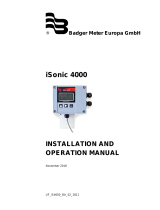
Contents Page
1. Basic safety precautions .................................................................................................. 1
2. System description ............................................................................................................ 2
3. Installation .......................................................................................................................... 3
3.1 General information ................................................................................................... 3
3.1.1 Temperature ranges ....................................................................................... 3
3.1.2 Protection class .............................................................................................. 3
3.1.3 Transport ........................................................................................................ 4
3.2 Installation .................................................................................................................. 4
3.2.1 Meter orientation ............................................................................................. 4
3.2.2 Inlet and outlet pipe ........................................................................................ 4
3.2.3 Meter location ................................................................................................. 5
3.2.4 Pipe reducer requirements ............................................................................. 6
3.2.5 Separate version ............................................................................................. 7
3.2.6 Grounding and potential equalization ............................................................. 7
3.2.7 Plastic or lined pipelines ................................................................................. 8
3.2.8 Pipelines with cathodic protection ................................................................... 8
3.2.9 Electrically disturbed environment .................................................................. 9
4. Power connections ............................................................................................................ 9
4.1 Auxiliary power ........................................................................................................... 9
4.2 Separate version ...................................................................................................... 10
4.2.1 Signal cable specification ............................................................................. 11
4.3 Configuring input/output (I/O) ................................................................................... 12
5. Programming ................................................................................................................... 13
5.1 Quick Setup………………………………………………………………………………..
.13
5.2 Main menu………………………………………………………………
……………………15
5.2.1 Meter Setup……………………
.………………………….....……………………….15
5.2.2 Measurement………………………………………………………….…………..16
5.2.3 Inputs and Outputs………………………………………………………………..19
5.2.4 Clear Totals………………………………………………………………………..24
5.2.5 Communications………………………………………………………………… .25
5.2.6 Advanced…………………………………………………………………………..27
5.2.7 Info/Help…………………………………………………
…………………………30
5.2.8 Language Select………………………………………………………………….31
6. Troubleshooting .............................................................................................................. 32
6.1 Replacing the fuse ................................................................................................... 33
6.2 Replace meter’s electronics ..................................................................................... 33
7. Technical data .................................................................................................................. 34
7.1 Detector type II ......................................................................................................... 34
7.2 Detector type Food .................................................................................................. 36
7.3 Detector type III ........................................................................................................ 38
7.4 Meter type M2000
®
.................................................................................................. 39
7.5 Error limits ................................................................................................................ 40
7.6 Size selection ........................................................................................................... 41
8. Program structure ........................................................................................................... 42
9. Return of goods for repair .............................................................................................. 44





























